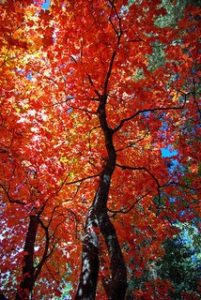
This is one of my very favorite times of year; on sunny days, the low-angle sunlight makes the colorful leaves on the trees glow. “Season of mists and mellow fruitfulness,” Keats wrote in his poem “To Autumn,” but it’s also the season of some interesting chemistry. To celebrate the brilliant hues of Northern Hemisphere autumn, today we’ll look at the names of the chemicals that give the leaves their color.
The green in leaves in the spring and summer comes from chlorophyll, the chemical that makes photosynthesis possible. The word chlorophyll was coined in the early 19th century. It has two Greek roots. Khloros means pale green, and phyllon means leaf. (That one also appears in phyllosilicate, which describes clay minerals with thin sheets, or leaves, of silica; it also appears in phyllo dough.)
Leaves also contain carotenoids during much of their lifetimes. These pigments provide yellow, red, and orange colors in the plant world. For example, in about six months we’ll be seeing the cheery yellow of a carotenoid in daffodils. As some fruits mature, we see the chlorophyll slowly disappear as the green fruit ripens to yellow, orange, or red. You may have heard of lycopenes or β-carotene, which are considered micronutrients in foods. (I talked about lycopenes and their unlikely etymological connection to wolves in an earlier post.) The words carotene and carotenoid come from carote, the Latin word for that iconic orange vegetable, the carrot.
Something similar to the ripening of fruit happens in leaves in the fall: as trees prepare for winter and shut down photosynthesis in their leaves, the chlorophyll fades away and the carotenoids that they contain become more obvious. In addition, some fruits and many trees also begin to produce another pigment, anthocyanin, in response to the shorter days of fall. It also contributes to the colors of the fall foliage as the chlorophyll disappears. Anthocyanin, like chlorophyll, comes from two Greek roots: anthos, for flower, and kuanos, for blue.
So now you know what sets the woods and tree-lined streets ablaze: the chlorophyll is disappearing, and the carotenoids and anthocyanin are shining forth. It goes by fast; enjoy!
Learn more:
- Fall colors page and an overview of the science behind fall colors from the US Forest Service
- Chemistry of Fall Colors from scifun.org (more detail on the chemistry)
- Centripetal Fall Colors from Earth Science Picture of the Day (why some trees change color from the top down)
- Carotenoids page at the Linus Pauling Institute’s Micronutrient Center
- In October 1862, the Atlantic published Henry David Thoreau’s essay Autumnal Tints, in which Thoreau presents his careful observations as a naturalist and builds thoughtful analogies to human life and death. It’s a beautiful autumn read.